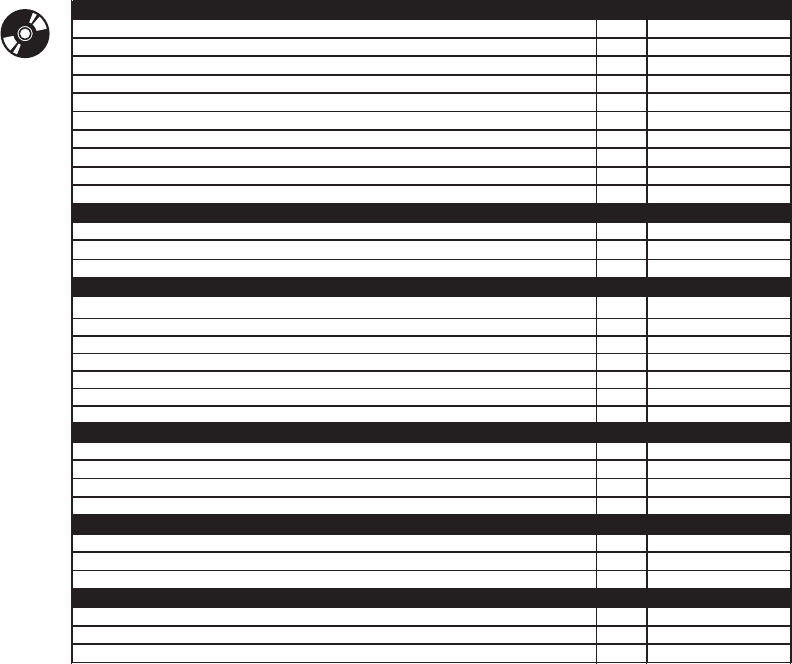
CODE RELEASING
In This Chapter
• Determining Code Release
• Code Release Checklist
• Gold Masters
23.1 I
NTRODUCTION
W
hen a game is code released, it means the content is final, the bugs are
addressed, and the master disc is ready to be replicated and packaged.
A code release process should be in place to ensure that everything
that needs to be done on the game has been completed correctly. This process
will involve daily meetings to discuss bugs, a code release checklist, procedures
for submitting to a third-party for approval, and information on where to send
the code for replication. A game doesn’t get code released overnight, the process
can take anywhere from five days to two months, depending on the complexity of
the game and who needs to approve it before it is code released.
23.2 DETERMINING CODE RELEASE
Define a code release process so that the development team and QA depart-
ment are in agreement about when a game is ready for code release or final
submission if it needs to be submitted to a third-party for approval. Treat
this as a separate phase in the testing process, and be sure to check the code
Chapter 23
376 THE GAME PRODUCTION HANDBOOK, 2/E
release candidate against the entire test plan and, if necessary, the technical
requirements checklists for Sony, Microsoft, or Nintendo. In addition, this is an
ideal time to double-check that the copyright and other legal information is cor-
rect, that all the appropriate age ratings have been secured, and that the local-
ized versions of the game have been approved by the appropriate people.
The main purpose of the code release process is to fully verify that the actual
master disc of the game that is sent for replication and manufacturing contains
all the correct code and assets. The process should be able to uncover any major
issues that need to be addressed before the game ships. The process should plan
for enough time to run through the entire testing plan and technical require-
ments list at least three times, and include any additional time needed for Sony,
Microsoft, and Nintendo approvals (usually four to eight weeks). Additional time
in the code release schedule allows time to address any issues with potential gold
master candidates and prepare a new master that can then be verified.
A code release candidate (CRC) is a version of the game that has addressed
all the bugs, has all the final assets, and is deemed ready to ship by the develop-
ment team. A game may have several CRCs during the code release process in
order to address any major issues that are uncovered. When QA receives a CRC,
they will check the game against the test plan and other code release require-
ments. Depending on how large the test plan is, this could take anywhere from
five to seven days. You may want to staff up the QA department in order to get
through the process more quickly, as saving a day or two at the end of the testing
phase can make the difference between making or missing a ship date.
Note that any game appearing on proprietary hardware such as a console or
cell phone, must be submitted to a third-party for approval. Each hardware man-
ufacturer has different requirements to fulfill before the game is approved for
replication. More information on the third-party approval process is discussed
later in this chapter.
23.3 CODE RELEASE CHECKLIST
Create a code release checklist to ensure that code release requirements are
clearly defined and understood by everyone. Figure 23.1 is an example of code
release checklist. This only provides a general overview of the types of things to
include, add, or modify anything that relates specifically to your game.
In addition, you may want to include additional information about the fol-
lowing on the checklist, as all of these items should be double-checked on the
CRC as well:
Copyright information: Usually listed in the game and on the packaging.
This includes checking the placement of all logos from third parties, such as
middleware providers, developers, and third-party manufacturers.

CODE RELEASING 377
End User License Agreements: Usually included in the manual. PC
games may also have a version that displays during the installation process.
Licensor Approval: If the game is based on a specific license (such as Harry
Potter), be sure to secure appropriate approvals from all licensors.
Customer Support Information: This includes phone numbers and
web sites. International versions will have different customer support
information.
Localized assets: Double-check that localized assets display correctly in
the game.
Demos: If including demos from other games, be sure they have the appro-
priate age ratings for any territories in which the game is released.
GENERAL INFORMATION P/F Additional Notes
Have all bugs been addressed?
All "will not fix" bugs approved?
Can game be played from beginning to end?
Have cheat code been removed?
Is debug software removed?
Has game passed all areas of the test plan?
PC Compatibility checks completed?
Is correct customer support information listed?
Is this version approved for submission to third parties?
Are the correct age ratings and disclaimers being displayed?
THIRD PARTY APPROVALS
Has this version passed the technical requirements checks for Microsoft?
Has this version passed the technical requirements checks for Sony?
Has this version passed the technical requirements checks for Nintendo?
LOCALIZATIONS
Is correct customer support information listed?
Is game text displaying the correct language?
Are voiceovers playing in the correct language?
Are packaging manuals translated correctly?
Has game received linguistic approval?
Does correct legal text and copyright information display?
Does game have all necessary age ratings?
LEGAL
Have appropriate licensors signed off on the game?
Are clearances secured for all licensed content (such as music)?
Does game contain correct version of the EULA?
Is warranty and customer support info correct?
PACKAGING
Does package contain legal and copyright information?
Are logos and other icons on package correct?
Is the manual finalized and approved?
GOLD MASTER CHECKS
Have gold masters beeen virus scanned and determined to be virus free?
Is gold master identical to the approved gold release candidate?
Has gold master been installed and verified on appropriate hardware?
FIGURE 23.1 Code release checklist.
O
N
T
H
E
C
D
378 THE GAME PRODUCTION HANDBOOK, 2/E
Software ratings: Ensure the game has the appropriate rating for each
territory in which the game will ship, and that the game and packaging
include the required icons and logos.
Console submission requirements: Check the game against the technical
requirements checklist for Sony, Microsoft, and Nintendo.
23.4 GOLD MASTERS
The replication and packaging of gold masters for PC games will be handled di-
rectly by the publisher. The publisher selects a replication vendor and will send
the vendor the final code when it is has been approved. Many vendors have an
electronic submission process set up to receive code, while other vendors require
you to give them actual gold master discs. In either case, be sure to understand
who is supposed to get the final code and what format is required.
Console gold masters have one more step to complete before they can be
sent to the replication house. Sony, Microsoft, and Nintendo need to approve the
game before it can be released for any of their systems. An account manager is
assigned to work with the developer and publisher, and is responsible for guiding
the game through the approval process. Each company has a different process
so the account manager is an invaluable resource in understanding the technical
requirements, the approval phases, and packaging requirements. The account
manager will work closely with the team to determine when the game needs to be
submitted in order to hit the target ship date. Keep in close contact with your ac-
count manager throughout the process in order to navigate the approval process
as smoothly as possible.
Build time in the schedule for the approval process. Not only does the
final submission need to be scheduled (which on average takes about 10 to 20
days), but other submissions are also required during the course of develop-
ment. Most console manufacturers require a beta version of the game to be
submitted several weeks or several months before the final submission. This
gives them an opportunity to check the game’s progress and offer any feedback
on things that may get written up during final approval. Think of it as a sneak
preview and an opportunity to address any areas in the game that may impact
final approval.
Once the game enters the final submission phase, it may take the console
manufacturer 10 to 15 days to come back with a decision. Hopefully, everything
goes smoothly and the game passes on the first try. While games do pass on the
first try, it doesn’t happen very frequently, so it is better to assume the game
needs to be submitted at least twice before it gets final approval.
If the game fails the initial submission, the console manufacturer will
generate a report detailing the cause. The failures are all related to things in

CODE RELEASING 379
the technical requirements checklist, so the report will reference the specific
requirement that was not fulfilled. Depending on how severe the issues are, the
development team can expect to implement the bug fixes and feedback in a few
days or weeks, and submit the game for a second time. Hopefully, the issues
have been addressed and the game passes.
Console packaging also needs to be submitted for approval. In most cases, the
packaging has a submission process that is separate from the gold master, and is
usually handled by someone from marketing or creative services. However, add
this task to the production schedule, because if the packaging is not submitted
in a timely fashion, the game’s ship date can be jeopardized, even if the code has
already been approved. Packaging approval takes about 10 to 14 days, and can
be submitted whenever it is finalized by the publisher.
Once the PC and console gold masters are approved and ready for manufac-
turing, they will be sent to the replication vendor. The vendor generally needs
about 10 days to copy discs and get them packaged. This assumes that they re-
ceive all the printed parts on time and don’t run into any issues with copying
the discs. Before mass copies of the discs are created, the vendor will make a
few test masters (sometimes called “glass masters”) and have someone from the
publisher verify that the discs are working correctly.
As the project comes to a close, keep people informed of any changes to the
code release schedule as this will also affect the ship date. Figure 23.2 provides
a general overview of a production and release schedule for a console game. The
schedule begins with submitting the beta version of the game to the console
manufacturer for feedback on June 2, 2008. The team has about six more weeks
to polish the code, implement feedback, and prepare a CRC. The CRC process
starts on July 28, 2008 and is ready for console submission 10 days later. After
scheduling two rounds of submission, manufacture ring, and shipping dates, the
game is estimated to hit store shelves on October 7, 2008. Note that it took about
FIGURE 23.2 Production and release schedule for a console game.
..................Content has been hidden....................
You can't read the all page of ebook, please click here login for view all page.
